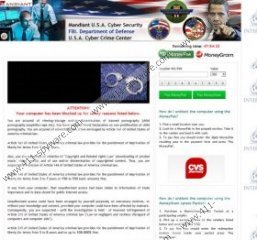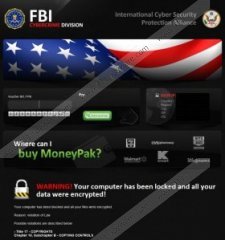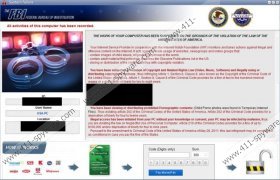FBI Virus Removal Guide
The clandestine FBI Virus is presented as a screen locking notification which can be presented from your desktop or your browser. The virus is actually a ransomware because it uses intimidation to trick you into paying a ransom; however, this is the last thing you should do. The name of the threat derives from the credentials of the Federal Bureau of Investigation (FBI) which may be attached to a variety of different notifications. Even though the alerts may vary, the content and the purpose remain the same. The fake notifications are used to trick you into thinking that Police, FBI and other law enforcers have discovered illegal activity performed from your personal computer. You are then informed that you can avoid huge fines, imprisonment and other intimidating outcomes by paying relatively small fines, which may span from $50 to $400 and up. Instead of paying this sum, you need to delete FBI Virus.
FBI Virus may have tens of different interfaces, and because of this computer users may recognize it by different names. Some of the infections which illegally use the FBI credentials include FBI Moneypak, Federal Bureau Investigation Virus, FBI Cybercrime Division Virus, FBI Online Agent has Blocked your computer for security reason Virus, Urausy FBI Ransomware and FBI PayPal Virus. Even though in most cases these ransomware infections are targeted at computer users living in the United States, you could find them corrupting your operating system even if you live elsewhere. Many of these threats are managed by such clandestine Trojans as Urausy, Reveton, Flimrans or Revoyem. If you do not remove these infections from the PC, they can block the Task Manager and reconstruct the Windows Registry to enable the lock-down of the computer or the web browsers. These Trojans are also responsible for releasing fictitious notifications crammed with fictional accusations. Here’s an example:
The work of your compute has been suspended on the grounds of the violation of the law of the United States of America […]
You have been subjected to violation of Copyright and Related Right Law (Video, Music, Software) and illegally using or distributing copyrighted contents […] this law infrigment may be considered as conditional in case you pay the fine of the States.
As you can see, schemers who have created this alert attempted to employ an authoritative tone; however, they have missed grammatical mistakes, which is a sign that this alert is fictitious. Needless to say, you do not need to pay any money via Ukash, Paysafecard, MoneyPak, Moneygram, or any other presented money transfer systems. Even though these are authentic, they are difficult to track, which means that after you pay the money – it is gone for good. If you do not want to lose your money to schemers, you should remove FBI Virus without further delay. This threat is extremely difficult to delete manually; however, automatic malware removal software will have no problems getting it deleted. What is more, an authentic malware remover will get rid of other malicious programs running alongside the ransomware.
Delete FBI Virus
Delete from Windows 8:
- Tap the Windows key to access the Metro UI menu and move the cursor to the bottom right corner.
- As the Charm Bar appears, click Settings and then move to Change PC Settings.
- Click General, navigate to Advanced Startup and click Restart Now.
- Select Troubleshoot, click Advanced Options and then Startup Settings.
- Now click Restart and select F5 to reboot the PC in Safe Mode with Networking.
- Launch a browser and visit http://www.411-spyware.com/SpyHunter .
- Download and install a reliable malware removal tool to delete all existing computer threats.
Delete from Windows Vista/Windows 7:
- Restart the PC, wait for BIOS screen to disappear and start tapping F8 on the keyboard.
- Select Safe Mode with Networking using the arrow keys on the keyboard and tap Enter.
- Download an authentic malware removal tool from http://www.411-spyware.com/download-sph .
- Follow the provided instructions to install the application on your personal computer.
- Perform a system scan and click Fix Threats to delete all existing malware.
Delete from Windows XP:
- Restart the PC and wait for BIOS to load.
- Start tapping F8 to access the Windows Advanced Options Menu.
- Using arrow keys select Safe Mode with Networking and tap Enter.
- As the ‘Windows is running in safe mode’ alert shows up – click Yes.
- Go to http://www.411-spyware.com/download-sph and click Download.
- Save the installer of an authentic malware remover.
- Now open the Start menu and launch RUN.
- Enter msconfig and click OK.
- In the System Configuration Utility click the Startup tab.
- Select Disable All and click OK.
- Restart the PC in the Normal Mode.
- Install the downloaded malware remover to delete all existing threats.
FBI Virus Screenshots:




